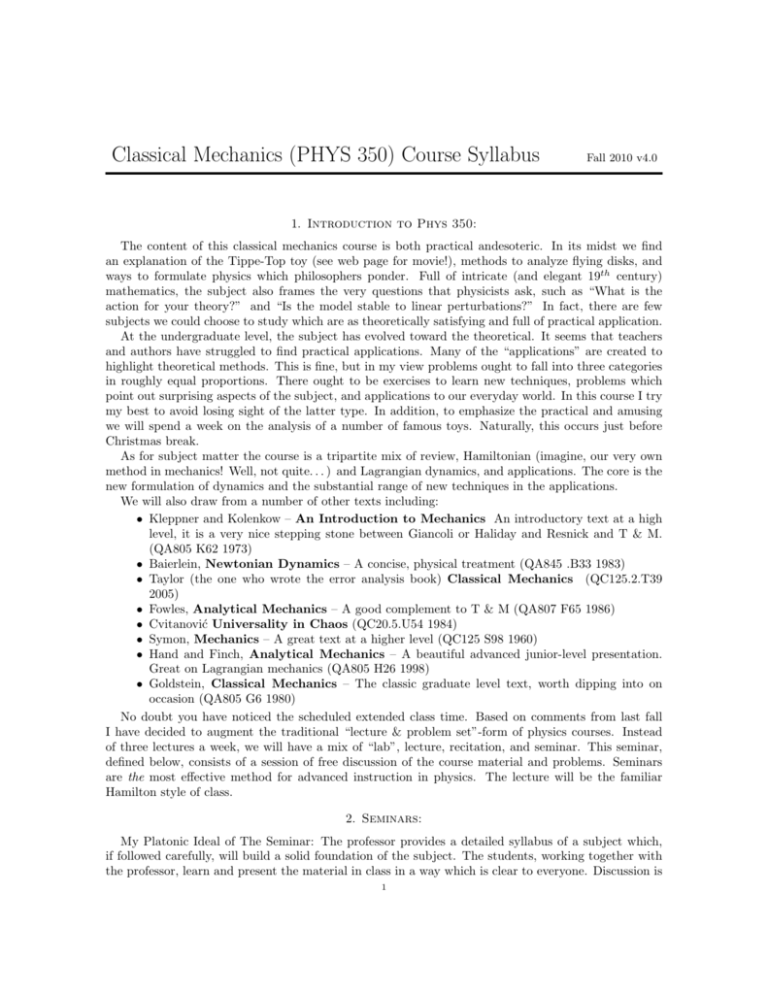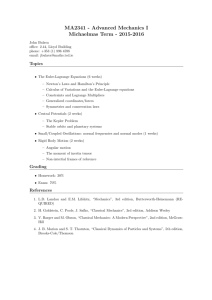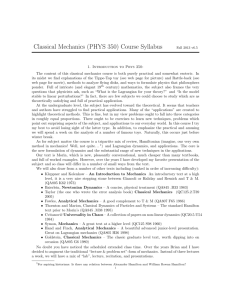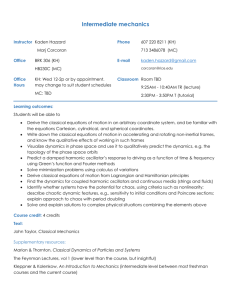Classical Mechanics (PHYS 350) Course Syllabus
advertisement

Classical Mechanics (PHYS 350) Course Syllabus Fall 2010 v4.0 1. Introduction to Phys 350: The content of this classical mechanics course is both practical andesoteric. In its midst we find an explanation of the Tippe-Top toy (see web page for movie!), methods to analyze flying disks, and ways to formulate physics which philosophers ponder. Full of intricate (and elegant 19th century) mathematics, the subject also frames the very questions that physicists ask, such as “What is the action for your theory?” and “Is the model stable to linear perturbations?” In fact, there are few subjects we could choose to study which are as theoretically satisfying and full of practical application. At the undergraduate level, the subject has evolved toward the theoretical. It seems that teachers and authors have struggled to find practical applications. Many of the “applications” are created to highlight theoretical methods. This is fine, but in my view problems ought to fall into three categories in roughly equal proportions. There ought to be exercises to learn new techniques, problems which point out surprising aspects of the subject, and applications to our everyday world. In this course I try my best to avoid losing sight of the latter type. In addition, to emphasize the practical and amusing we will spend a week on the analysis of a number of famous toys. Naturally, this occurs just before Christmas break. As for subject matter the course is a tripartite mix of review, Hamiltonian (imagine, our very own method in mechanics! Well, not quite. . . ) and Lagrangian dynamics, and applications. The core is the new formulation of dynamics and the substantial range of new techniques in the applications. We will also draw from a number of other texts including: • Kleppner and Kolenkow – An Introduction to Mechanics An introductory text at a high level, it is a very nice stepping stone between Giancoli or Haliday and Resnick and T & M. (QA805 K62 1973) • Baierlein, Newtonian Dynamics – A concise, physical treatment (QA845 .B33 1983) • Taylor (the one who wrote the error analysis book) Classical Mechanics (QC125.2.T39 2005) • Fowles, Analytical Mechanics – A good complement to T & M (QA807 F65 1986) • Cvitanović Universality in Chaos (QC20.5.U54 1984) • Symon, Mechanics – A great text at a higher level (QC125 S98 1960) • Hand and Finch, Analytical Mechanics – A beautiful advanced junior-level presentation. Great on Lagrangian mechanics (QA805 H26 1998) • Goldstein, Classical Mechanics – The classic graduate level text, worth dipping into on occasion (QA805 G6 1980) No doubt you have noticed the scheduled extended class time. Based on comments from last fall I have decided to augment the traditional “lecture & problem set”-form of physics courses. Instead of three lectures a week, we will have a mix of “lab”, lecture, recitation, and seminar. This seminar, defined below, consists of a session of free discussion of the course material and problems. Seminars are the most effective method for advanced instruction in physics. The lecture will be the familiar Hamilton style of class. 2. Seminars: My Platonic Ideal of The Seminar: The professor provides a detailed syllabus of a subject which, if followed carefully, will build a solid foundation of the subject. The students, working together with the professor, learn and present the material in class in a way which is clear to everyone. Discussion is 1 2 active, intellectually challenging, non-threatening, and pushes the envelope of everyones understanding. In preparation every member has no problem asking others about a solution, an integral, or definition. In seminar any remaining questions are discussed in depth resulting in new insights which, naturally, arrive with a blinding flash of light. The typical seminar consists of a series of solutions and 10-15 minute presentations punctuated by discussion. We all contribute but I emphasize the complete reversal of roles. You take an active role in teaching yourselves. It is your class! There is but one rule: Except for your final toy presentation, there will be no PowerPoint presentations. Here are a few suggestions to help you along: (1) Nothing will help you better than to start preparing for seminar early. As good as they are, these chapters are not short stories; it would be unpleasant to read the entire chapter in one sitting. Further, read with a scratch pad and writing utensil; work through the presentation of the text. Allow plenty of time. Slogan: “Start early. Work slowly and carefully.” (2) Dance is not learned by only watching a video; physics is not learned by only reading. To learn the subject one must try out the stuff by talking and writing about it and working through problems. For many of us this process has two purposes. One is to gain mathematical fluency. The other is to find the physics in the mathematics. Slogan: “Do all the problems.” (3) One of the aspects of the seminar experience that took me the longest to learn was the utility of asking a question. If you encounter difficulty, carefully formulate a question (often the question answers itself in this process!), then ask someone. If this person is madly preparing a midterm or a bernaise sauce or does not know the answer, try someone else. In particular do not hesitate to ask me (Science G052, x4919, smajor). If all else fails, go on to other problems and return to the question later. The slogan is: “Minimize frustration!” (4) When writing solutions keep in mind that there is also a large difference in sketching a solution on your napkin at dinner and writing up the solution so that someone can read it (that may include you!) As with much writing, keep your audience in mind. Keep your classmates in mind but also try thinking of yourself in 3 months. The logical argument of your solution should be clear on a first read. (5) Much of what is true for solutions also applies to presentations. Clearly state the issue or problem, outline the tools needed, and proceed providing information when needed. Feel free to skip algebraic steps once you have cleared it with the class. Show us (including me) something we don’t already know, e.g. a new numerical solution or a experimental manifestation of a problem. Slogan: “To do well: Be clear. To impress, exhibit novelty.” (6) The best policy is to prepare fully for seminar before we meet and write up summaries and/or complete solutions after the actual seminar. It is not easy to keep up. But your notes will be loads of help for graduate school classes, qualifying exams, and even when you teach this course! Think of this as writing up notes from which you can relearn the subject. (7) It is never too early (or too late) to start being clear about what you understand and what you do not. There is a vast, amorphous plain between familiarity and understanding. Question your own understanding by trying it out on new situations. If your knowledge is not what is required, find the difference and learn from it. (8) If you haven’t already started, start keeping a sheet of paper with useful formulae so you can quickly answer questions such as, what is the spherical coordinate volume element? 3. Text: Thornton and Marion, Classical Dynamics of Particles and Systems 5th edition. 3 4. Colloquium: On a few Mondays during the semester we will have speakers from other colleges and universities come a speak on their research. Please make every effort to attend these; they give you an idea about the sort of research that is done and they are part of your physics education. In addition Steve Strogatz will be giving the Plant Lecture on September 20 (7:30 PM Chapel). An applied mathematician, he works in areas closely related to non-linear physics. He also is a guest columnist for the New York Times. It should be a great talk. 5. Course info: All materials will be available online. You can find them through the Courses tab on my homepage http://academics.hamilton.edu/physics/smajor/index.html. The latest versions will be labeled by a version number in the top right of the first page. 6. Grades: There are 3 parts to the grade: (1) Problem sets, labs and seminar participation (30 %): Weekly-ish assignments will be posted and distributed at least one week prior to the due date. I encourage you to work together you but must write up your own solutions. If you received a significant idea from someone else, please cite them. You may know that essentially all the solutions are available online on sites like Cramster and Course Hero. If you make use of these, cite your source. I highly recommend that you grapple with a problem before you look for help from me, your classmates, or online. Your presentations will be assessed for clarity and novelty. (2) Mid-term: (30 %) The exam will be Friday October 8. (3) Final (40 %): The final will take place at the regular scheduled time for MWF 1 PM classes, Wednesday December 15 2-5 PM. 7. Weekly Schedule Given how the semester starts, the “week” starts on a Thursday. What follows is preliminary! Week 26 August 2 September 9 September 16 September 23 September 30 September 7 October 14 October 21 October 28 October 4 November 11 November 18 November 25 November 2 December 15 December Enjoy! Topic Newtonian Mechanics I: Point particle Newtonian Mechanics II: Rockets & Gravitation Oscillations and Phase Space Non-linear Oscillations New Tools I: Calculus of Variations New Tools II: Lagrangian & Hamiltonian Dynamics Dynamics problems Fall break Central Force Motion Systems of Particles Non-inertial reference frames Dynamics of Rigid Bodies Coupled Oscillations Thanksgiving No classes Toy Week! (and review, too) Reading Ch 2 (42 pages) Ch 5 and 9.11 (29 pages) Ch 3.1-3.8 (30 pages) Supplements Ch 6 (19 pages) Ch 7.1-11 (44 pages) Exam Ch 7.12 -7.13 (8 pages) Ch Ch Ch Ch Ch 8 (36 pages) 9.1-9.10 (43 pages) 10 (21 pages) 11 (52 pages) 12 (30 pages) Ch 11 Projects Final Wednesday 2-5PM 4 Seth Major Science G052 x4919 smajor@hamilton.edu







